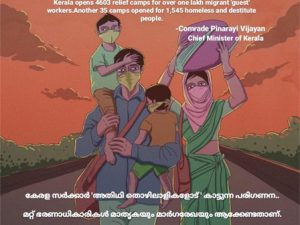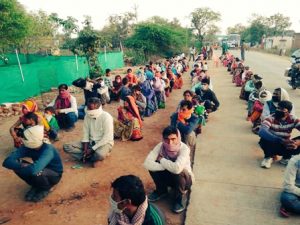Migrant Exodus During the National Lockdown
States have to ensure best approaches to manage migrant exodus during the national lockdown to stop the community transmission of COVID-19.

In the wake of the COVID-19 crisis, India went into a nationwide lockdown from 24 March midnight for 21 days. This is to contain the crisis by curtailing mobility with the announcement being made just four hours in advance. The states have implemented this lockdown pretty efficiently with the fervent hope that it will flatten the curve. One section of society that has been severely affected by the sudden announcement of lockdown is the migrant workers who live on daily wages and have almost no savings for a rainy day. According to 2011 census, about 78 million migrants are hosted in Indian urban areas whose homes are in villages in rural India; of this, 20 million are interstate migrants. The majority of these migrants are in the larger cities such as Mumbai, Delhi, Thane, Pune, Bengaluru, Chennai, Chandigarh, Surat and Ahmadabad, some of which are also the hotspots of the current COVID-19 pandemic.
The loss of livelihood prompted an exodus of migrant workers from all major cities only to be left stranded in huge crowds at inter-state bus stations, major railway stations and state borders due to halting of all public transport. On Saturday, the home minister announced that the centre committed all support to migrant workers during lockdown. State ggovernments like UP had arranged for 1,000 buses to take the migrants back, while Punjab announced resuming its factories to let migrant workers continue to stay. Announcement of theavailability of transport resulted in massive number of migrants thronging the Anand Vihar bus terminus in Delhi on Sunday, desperate to get on a bus and go home. Kerala has also been reporting the similar incidents of migrant exodus. States like Kerala have pro-actively created shelters and community kitchens to ensure that the stranded ‘guest’ workers are assured basic amenities during this crisis period. And now, the Central Government has asked to close all state borders. The vital question to ask at this point is what is the best way to assist migrants during this growing pandemic.
Also Read : Covid 19 Conundrum Pandemic Of Epic Proportions
Due to the lack of adequate space for social distancing or practising hygiene, the minimum requirement for ensuring safety during the pandemic, these migrants pose a high risk of being infected and becoming carriers.
Their return to their hometowns and villages can cause further spread of the disease to areas that may otherwise be unaffected.

Does rural India have the infrastructure and amenities to combat this disease? NSSO data (2018) shows that two-thirds of rural households and almost half of the urban households in India do not have adequate infrastructure (separate rooms, bathroom inside house or running water) for a person to stay in home quarantine. Almost 75 per cent of rural households use communal water sources, 45 per cent use communal washrooms and 40 per cent use communal latrines. In such a scenario, how will the migrants returning to their families in the rural parts of India ensure social distancing? We have seen reports of return migrants isolating themselves in forests and trees for the safety of their families. And these areas do not have the health care infrastructure to cope with massive community outbreaks, which will be the result of the migrant’s movement.
This brings forth the question of alternative measures to ensure the welfare of these migrants who have no access to food, livelihood and shelter, let alone social distancing and hygienic practices. In our opinion, helping the migrants to stay put wherever they are for as long as necessary in state-run facilities with adequate provisions, health facilities and monitoring will be the best path to avoid the spread of the disease. Within these shelters, hundreds of migrants are housed with bare minimum facilities, and there are more stranded without any access to shelter. Also, a major vulnerability in these camps is the fact that there is no space for social distancing, and if there are workers who are currently infected (asymptomatically), then there is a high risk of the spread of the virus. When the impact of the pandemic worsens, will the ggovernment be able to continue to provide at least the bare minimum to these people?
Also Read : Is Keralas Development Not Migrant Inclusive
One option that can help alleviate the load on the ggovernments in the current scenario is to utilize resources that are lying unutilized or underutilized due to the lockdown.
For example, hotels, hostels schools and colleges that are closed can be converted to temporary shelters for migrants through concerted efforts so that the minimum requirement of sanitation and social distancing can be ensured. Similarly, there should be accumulation of food and other raw materials at public and private procurement facilities, restaurants and throughout their supply chains. These goods and their kitchen can be used to cook and supply food for not just migrants but also other vulnerable and marginalized populations in cities through co-ordinated efforts of private–public partnerships.
We have seen countries like Italy and Iran converting hotels to isolation facilities for infected persons when the hospital infrastructures started becoming scarce. If India used these facilities to enable healthy citizens to practice social distancing, we may be able to pre-empt the spread of the disease. The social and economic position of the individual or his place of origin shouldn’t determine the value of his life. Only a concerted effort of the public sector in partnership with private entities can help us tide over this crisis with minimum causalities. During the national lockdown, states have an unfailing duty to stop the migrants’ movements by providing them food, shelter, sanitation facilities in order to stop the community transmission of COVID-19 in India.
